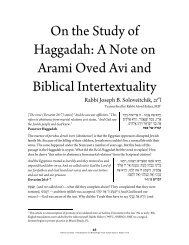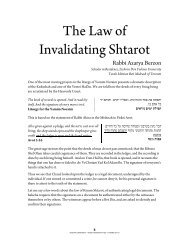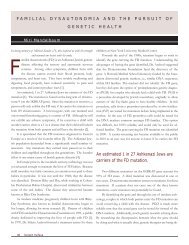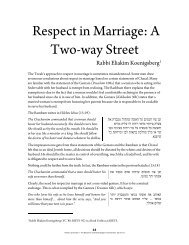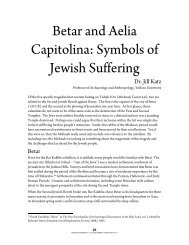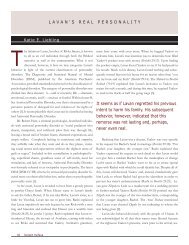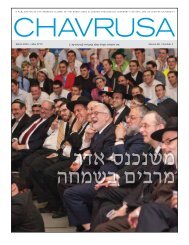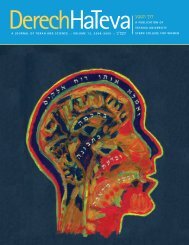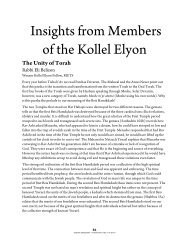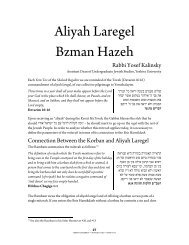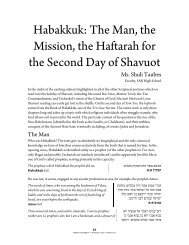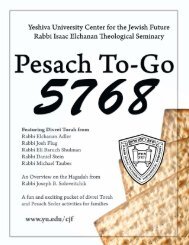Create successful ePaper yourself
Turn your PDF publications into a flip-book with our unique Google optimized e-Paper software.
Profiles in Churban 1<br />
<strong>Rabbi</strong> <strong>Reuven</strong> <strong>Brand</strong><br />
Rosh Kollel, Yeshiva University <strong>Torah</strong> Mitzion Kollel of Chicago<br />
Introduction<br />
Tisha Bav sharpens our awareness of the immeasurable loss of the Beit Hamikdash, as we mourn<br />
and lament its destruction. Yet, the Midrash suggests that there is, in fact, a greater devastation<br />
than the loss of the house of G-d. The rabbis of the Midrash tackle a difficult passage in<br />
Tehillim, which begins:<br />
A Psalm of Asaf. God, the nations have come into<br />
Your inheritance; they have desecrated Your Holy<br />
Temple; they have turned Jerusalem into heaps.<br />
Tehillim 79:1<br />
תֶא , וּאְמִּט<br />
The Midrash explains the difficulty and the resolution:<br />
A Psalm of Asaph. God, the nations have come into Your<br />
inheritance. The text should have used a phrase like, 'Weeping of<br />
Asaf,' 'Lament of Asaf,' 'Dirge of Asaf'; why does it say, 'A psalm<br />
of Asaf'? It may be likened to a king who erected a bridalchamber<br />
for his son which he plastered, cemented, and<br />
decorated; but his son entered upon an evil course of living. The<br />
king immediately ascended to the chamber, tore the curtains and<br />
broke the rods; but [the son's] tutor took a piece of rod which he<br />
used as a flute and played upon it. People said to him, 'The king<br />
has overthrown his son's chamber and you sit playing a tune!'<br />
He replied to them, 'I play a tune because the king overturned his<br />
son's chamber but did not pour out his anger upon his son.'<br />
Similarly people said to Asaf, 'The Holy One, blessed be He, has<br />
caused Temple and Sanctuary to be destroyed, and you sit singing<br />
a Psalm!' He replied to them, 'I sing a Psalm because the<br />
Holy One, blessed be He, poured out His wrath upon wood and<br />
stone and not upon Israel …<br />
Eicha Rabbah 4:14 (adapted from Soncino Translation)<br />
5<br />
Yeshiva University • A To-Go Series • Av 5772<br />
- ךֶָתָלֲחַנְבּ םִיוֹג וּאָבּ , םיִהלֱֹא : ףָסאְָל , רוֹמְזִמ<br />
. םיִיִּעְל םִ ַלָשׁוּרְי-תֶא<br />
וּמָשׂ ; ךֶָשְׁדָק לַכיֵה<br />
א:<br />
טע םיליהת<br />
םיוג ואב םיקלא ףסאל רומזמ<br />
רמימל ךירצ ארק הוה אל ךתלחנב<br />
הניק ףסאל יהנ ףסאל יכב אלא<br />
אלא ףסאל רומזמ רמוא המו ףסאל<br />
ונבל הפוח תיב השעש ךלמל לשמ<br />
ונב אציו הרייצו הדייכו הדייסו<br />
ךלמה הלע דימ הער תוברתל<br />
רבישו תואליוה תא ערקו הפוחל<br />
בוביא ולש גוגדפ לטנו םינקה תא<br />
ול ורמא רמזמ היהו םינק לש<br />
תאו ונב לש ותפוח ךפה ךלמה<br />
ינא רמזמ םהל רמא רמזמו בשוי<br />
ךפש אלו ונב לש ותפוח ךפהש<br />
ףסאל ורמא ךכ ונב לע ותמח<br />
התאו שדקמו<br />
לכיה בירחה ה"<br />
בקה<br />
ינא רמזמ םהל רמא רמזמו בשוי<br />
םיצעה לע ותמח ה"<br />
בקה ךפשש<br />
לע ותמח ךפש אלו םינבאה לעו<br />
שא תציו ביתכד אוה אדה לארשי<br />
. היתודוסי לכאתו ןויצב<br />
די:<br />
ד הבר הכיא<br />
1 I would like to thank the following people for their assistance in the preparation of this article: <strong>Rabbi</strong> Hayyim<br />
Angel, <strong>Rabbi</strong> Josh Flug, Mrs. Ora Lee Kanner, <strong>Rabbi</strong> Menachem Leibtag, <strong>Rabbi</strong> Dr. Shnayer Leiman, Professor<br />
Leslie Newman, Dr. Haym Soloveitchik, Dr. Daniel Tsadik and Rev. Salomon Vas Dias.
At first glance, it is impossible to fathom associating the destruction of the Beit Hamikdash with<br />
a mizmor- a song. Yet, we learn that the rabbis viewed the destruction of the physical edifice of<br />
the Beit Hamikdash as an act of Divine kindness; instead of pouring his wrath on the Jewish<br />
people, the Divine punishment was meted out on the inanimate building materials of the<br />
sanctuary. 2 Despite the great tragedy that is the Churban Beit Hamikdash, the destruction of the<br />
Jewish people is an even more tragic loss.<br />
This observation is quite understandable. The Beit Hamikdash is valued because it serves as the<br />
focus of the Divine presence in this world. It is endowed with holiness because of its intense<br />
spiritual character and serves as a Kiddush Hashem (sanctification of G-d's name) bringing G-d<br />
into the space and focus of the world. However, there is a greater resting place of the Divine<br />
presence and source of Kiddush Hashem in the world: the Jewish people. We, the nation of<br />
Hashem, are charged with the awesome task of housing G-d in our lives and representing Him in<br />
this world. Perhaps even the Beit Hamikdash itself was only a means to channel G-d’s presence<br />
into the lives of the Jewish people, as it says:<br />
You shall make a Temple for me and I will dwell in them.<br />
Shemot 25:8<br />
6<br />
Yeshiva University • A To-Go Series • Av 5772<br />
. םכותב<br />
יתנכשו שדקמ יל ושעו<br />
ח:<br />
הכ תומש<br />
This is why the destruction of the people of Hashem is the ultimate Chilul Hashem (desecration<br />
of G-d's name), as we are the bearers of the Divine presence.<br />
Millions of Jews have walked the timeline of Jewish history, ending their lives sanctifying the name<br />
of G-d. Separated geographically and temporally, on Tisha Bav we remember them together and<br />
mourn their destruction just as we mourn the destruction of the Beit Hamikdash. Our traditional<br />
Kinnot make mention of some specific individuals and has allusions to many others.<br />
Specifically, the sages of Israel are the giants upon whom much of the responsibility to carry the<br />
name of Hashem rests. As the Midrash teaches, our forefathers were the merkavah laShechinah -<br />
the chariot of the Divine presence. 3 Hence, their demise in particular is akin to the destruction of<br />
the Beit Hamikdash. Perhaps this is why, in the context of the fast of Gedalya, the Talmud teaches:<br />
The fast of the seventh month is on the third of Tishrei, which is the<br />
day that Gedaliah ben Achikam was killed. Who killed him?<br />
Yishmael ben Netanya. [The fact that we fast for the murder of one<br />
person [teaches] that the death of the righteous is compared to the<br />
burning of the Holy Temple.<br />
Rosh Hashanah 18b<br />
ובש ירשתב 'ג<br />
הז יעיבשה םוצ<br />
וגרה ימו םקיחא ןב הילדג גרהנ<br />
ךדמלל<br />
וגרה הינתנ ןב לאעמשי<br />
םיקידצ לש ןתתימ הלוקשש<br />
. וניהלא תיב תפירשכ<br />
: חי הנשה שאר<br />
Thousands of <strong>Torah</strong> scholars over the millennia have perished al Kiddush Hashem, and we<br />
contemplate their loss of Tisha Bav. 4<br />
2 For the Halachic implications of this concept and its application on Tisha Bav, see Biur HaGra O.C. 554 s.k. 2.<br />
3 Ramban develops this concept in his brief introduction to his commentary on Sefer Shemot..<br />
4 Perhaps this is why, in our Mussaf of Yom Kippur, once we conclude the portion of the Avodah- the description of<br />
the Temple service- we lament our lack of a Beit Hamikdash and immediately follow it with a lament for the
Below is a tiny glimpse into the lives of several great <strong>Torah</strong> scholars whose martyrdom we<br />
contemplate on Tisha Bav. They span the vast reach of our exile and represent only a minute<br />
fraction of the number and stature of rabbinic figures, prominent bearers of the presence of G-d,<br />
whom we have tragically lost.<br />
<strong>Rabbi</strong> Chanina Ben Tradyon<br />
Eretz Yisrael, 2nd century<br />
We dedicate a specific Tisha Bav kinnah (Arzei Halevanon) to a group of Mishnaic <strong>Rabbi</strong>s who<br />
died during the Roman persecutions in the aftermath of the destruction of the Beit Hamidkash.<br />
There are four editions of a Midrash known as “Midrash Harugei Malchut” that describe what we<br />
call the story of the “Ten Martyrs.” The exact description of the Midrash, which presents a Roman<br />
tribunal condemning ten <strong>Rabbi</strong>s to death as punishment for the sale of Yosef, has been debated by<br />
scholars in terms of its historical veracity. Whether the precise details of the background are<br />
allegorical or historical is not germane to the purpose of the kinnah, which is to give us a sense of<br />
the excruciatingly difficult state of the Jews living in Israel after the Churban Beit Hamikdash. 5<br />
One of the ten martyrs mentioned in the kinnah is <strong>Rabbi</strong> Chanina (or Chanania) Ben Tradyon.<br />
<strong>Rabbi</strong> Chanina was a second generation sage of the Mishna who lived in Sakhnin in the Galilee<br />
during the Hadrianic persecutions of the second century. He was known to be a particularly<br />
scrupulous and pious individual, who was appointed as an overseer of the communal charity<br />
fund. His primary pursuit was the study of <strong>Torah</strong>, and his teachings and rulings appear in<br />
numerous locations in the Talmud. It was his unwavering commitment that ultimately brought<br />
his untimely demise as the Talmud records:<br />
They brought R. Chanina ben Tradyon and said to him "why<br />
did you study <strong>Torah</strong>?" He said to them "Because this is what<br />
my G-d commanded." Immediately, they sentenced him to<br />
death by fire, his wife to death by sword and his daughter to live<br />
among prostitutes.<br />
Avodah Zarah 17b<br />
The continuation of the passages describes the execution of <strong>Rabbi</strong> Chanina:<br />
They found R. Chanina ben Tradyon who was sitting and studying<br />
<strong>Torah</strong> and gathering many congregations [for study] and there<br />
was a sefer <strong>Torah</strong> in his lap. They brought him and wrapped him<br />
in the sefer <strong>Torah</strong> and wrapped him in bundles of branches and lit<br />
them on fire. They brought wool sponges and soaked them in the<br />
water and placed them on his heart so that he would not die<br />
7<br />
Yeshiva University • A To-Go Series • Av 5772<br />
ורמא ןוידרת ןב אנינח יברל והויתא<br />
רמא אתיירואב תקסע אק יאמא היל<br />
וילע ורזג דימ יהלא 'ה<br />
ינוצ רשאכ והל<br />
ותב לעו הגירהל ותשא לעו הפירשל<br />
. תונוז לש הבוקב בשיל<br />
: זי הרז הדובע<br />
ןוידרת ןב אנינח יברל והואצמ<br />
ליהקמו הרותב קסועו בשוי היהש<br />
וקיחב ול חנומ ת''סו<br />
םיברב תולהק<br />
והופיקהו ת''סב<br />
והוכרכו והואיבה<br />
תא ןהב ותיצהו תורומז יליבחב<br />
רמצ לש ןיגופס ואיבהו רואה<br />
ידכ ובל לע םוחינהו םימב םוארשו<br />
martyred rabbis of the Roman persecutions. This destruction, too, is not only a result of the destruction of the Beit<br />
Hamikdash but an approximate equivalent.<br />
5 <strong>Rabbi</strong> Menachem Leibtag notes that the reference to the sale of Yosef in the context of the aftermath of the<br />
destruction of the second Temple has a pointed message. The Talmud (Yoma 9) teaches that this Temple was<br />
destroyed due senseless hatred, the precipitant of the sale of Yosef.
quickly. His daughter said to him "Father, how can I see you like<br />
this?" He said to her, "If I were being burned alone, it would be<br />
difficult for me. Now that I am being burned with a sefer <strong>Torah</strong>,<br />
Whoever will seeks retribution for the desecration of the sefer<br />
<strong>Torah</strong> (i.e., G-d), will also seek retribution for my desecration."<br />
His students said to him, "Our teacher, what do you see?" He said<br />
"The parchments are burning but the letters are flying."<br />
Avodah Zarah 18a<br />
8<br />
Yeshiva University • A To-Go Series • Av 5772<br />
ול הרמא הרהמ ותמשנ אצת אלש<br />
הל רמא ךכב ךארא אבא ותב<br />
היה ידבל יתפרשנ ינא ילמליא<br />
ףרשנ ינאש וישכע יל השק רבדה<br />
לש הנובלע שקבמש ימ ימע ת''סו<br />
ול ורמא ינובלע שקבי אוה ת''ס<br />
רמא האור התא המ יבר וידימלת<br />
תוחרופ תויתואו ןיפרשנ ןוילג ןהל<br />
. חי הרז הדובע<br />
<strong>Rabbi</strong> Chanina’s devotion to <strong>Torah</strong> and its holiness is manifest in this nearly superhuman form<br />
of Kiddush Hashem. The image of the scroll burning with its letters soaring to heaven have<br />
accompanied generations of Jewish martyrs long after <strong>Rabbi</strong> Chanina’s passing.<br />
<strong>Rabbi</strong> Elchanan of Dampierre<br />
France, 12th century<br />
The twelfth and thirteenth centuries- the age of the Tosafists- was a period of remarkable<br />
Halachic creativity for Ashkenazic communities in France. Following a period of emphasis on<br />
exegesis by rabbinic luminaries including Rashi (1040- 1105), a seismic shift occurred as<br />
students began to embrace a new approach to Talmudic study: dialectic. This revolution was<br />
created by Rashi's grandson, <strong>Rabbi</strong> Yaakov of Ramerupt (1100- 1171), who analyzed the<br />
Talmud as an integrated whole and sought to resolve potentially conflicting passages with a new<br />
systematic, creative method. <strong>Rabbi</strong> Yaakov, known as Rabbeinu Tam, wrote little and his<br />
teachings might well have been lost had it not been for his nephew and student, <strong>Rabbi</strong> Yitzchak<br />
of Dampierre (d. ca. 1198), who organized and dictated these lessons to students who recorded<br />
them in writing.<br />
Despite this remarkable flourishing of <strong>Torah</strong>, the Jewish community was in a precarious<br />
position. The first crusade in 1096, which decimated the Jewish communities of the<br />
neighboring Rhine valley, incited violence in France, and the Jewish community of Rouen was<br />
destroyed. On the second day of Shavuot 1146, a band of marauders ransacked Ramerupt and<br />
beat Rabbeinu Tam, wounding him severely. The help of a passing nobleman enabled him to<br />
escape death. In 1171, a blood libel in Blois led to the burning of the entire congregation, which<br />
was commemorated in a fast day for centuries by European Jews.<br />
<strong>Rabbi</strong> Yitzchak of Dampierre, known as Ri, had four primary students, who wrote his teachings<br />
and the teachings of Rabbeinu Tam, known as Tosafot, on the various Talmudic tractates. The<br />
first of these four disciples was Ri’s son, <strong>Rabbi</strong> Elchanan. <strong>Rabbi</strong> Elchanan's wife was the sister of<br />
a well known Tosafist, <strong>Rabbi</strong> Shmuel of Falaise. His son, <strong>Rabbi</strong> Shmuel, was a noted Tosafist,<br />
who is cited in various Tosafot as <strong>Rabbi</strong> Shmuel ben <strong>Rabbi</strong> Elchanan. <strong>Rabbi</strong> Elchanan authored<br />
several Halachic works and responsa, in addition to Tosafot which he wrote. His students<br />
included noted French Talmudists <strong>Rabbi</strong> Yechiel of Paris and <strong>Rabbi</strong> Peretz of Corbeil. He was<br />
at least fifty years old and possibly in the midst of glossing tractate Avodah Zara, when he was<br />
killed in a pogrom in Dampierre in 1184 during the lifetime of his father.
<strong>Rabbi</strong> Isaac de Castro Tartas<br />
Brazil/ Portugal, 17 th century<br />
In the aftermath of expulsion of the Jews of Spain in 1492, the Catholic Church promoted a<br />
series of local church courts to investigate and prosecute Christian heretics, primarily those who<br />
had converted from Judaism and were suspected of maintaining their Jewish beliefs and<br />
practices. Known as the Inquisition, these courts tortured and killed myriads of Annusim, or<br />
Marranos, throughout the vast reaches of Christendom for centuries. Nonetheless, many “New<br />
Christians” continued to maintain their Jewish identity and practices.<br />
One such Jew was Isaac de Castro, whose parents had escaped Portugal and settled in Tartas, in<br />
southern France. Isaac was born around 1623 and was the brother of David Castro Tartas, a<br />
famous printer in Amsterdam, where his family had moved and practiced Judaism openly.<br />
Early in life, Isaac went to Parahiba, Brazil, where he lived for several years. He then moved to<br />
Bahia dos Santos in Brazil. Although he was not formally known as a haham, he was a deeply<br />
learned man, and reportedly was engaged in studying and teaching <strong>Torah</strong>. He was soon<br />
recognized as a Jew, arrested by the Inquisition, and sent to Lisbon. Summoned before the tribunal<br />
of the Inquisition, he at once reaffirmed his belief in Judaism and his determination to remain true<br />
to the faith. All the endeavors of the inquisitors to convert him to Christianity were in vain.<br />
On Dec. 15, 1647 he was led, together with five fellow-sufferers, to be burned at the stake. In the<br />
midst of the flames he called out, "Shema Yisrael,” a cry which deeply resonated with the Annusim<br />
of Portugal. In Amsterdam, the tragic end of this promising young man occasioned deep<br />
mourning. A memorial sermon was delivered, and elegies in Hebrew and in Spanish were written<br />
in his honor by prominent Jews, including a descendant of the Abravanel. The reign of terror of<br />
the Inquisition finally ended with its abolishment on March 30, 1782 by King Ferdinand IV.<br />
<strong>Rabbi</strong> Mann of Veizin<br />
Lithuania, 18th century<br />
In Veizin, a small suburb of Vilna, in the 18 th century, lived an apostate. Angered by the rejection<br />
and insults of the Jewish community, he set out to take revenge on his former coreligionists with<br />
a nefarious plan. One night ahead of the final days of Sukkot, the apostate stole an icon from a<br />
local Catholic church and hid it under the Aron Kodesh in the synagogue. He quickly went to<br />
the local parish priest and foretold an upcoming Jewish ritual in which the Jews would take a<br />
Christian icon and beat it with willow branches on a specific date. The news enraged the<br />
Christian authorities, who bided their time until the date which the apostate had mentioned:<br />
Hoshana Rabbah.<br />
On that fateful morning, while the Jewish community was assembled at prayer holding their<br />
hoshanot (willow branches), the local authorities burst into the shul and found an icon under the<br />
Aron kodesh. They immediately charged the Jews with crimes against the church. The Jews<br />
stood shocked, stunned in silence. This was interpreted as an admission of guilt, and an anti-<br />
Jewish pogrom was unleashed. Many Jews were beaten, maimed and killed. Those who<br />
9<br />
Yeshiva University • A To-Go Series • Av 5772
survived quaked with the fear of the unknown fate that would befall them after the formal trial<br />
that they would face.<br />
In the midst of this crisis, <strong>Rabbi</strong> Mann, an elderly pious member of the community secretly<br />
approached the Catholic authorities. 6 He figured that if he would accept the blame for the<br />
incident, then the rest of the community would be spared. The local authorities accepted his<br />
admission, and <strong>Rabbi</strong> Mann stood trial for his “crimes.” On the seventeenth of Tammuz, he was<br />
burned at the stake.<br />
For decades, the Jewish community of Vilna, the nearby major Jewish population center,<br />
observed annual memorial prayers in memory of “the Kadosh” <strong>Rabbi</strong> Mann, as he was known<br />
for his martyrdom including a unique אלמ לא,<br />
whose text is extant, that was composed in his<br />
memory.<br />
<strong>Rabbi</strong> Joseph B. Soloveitchik zt”l recalled as a young man hearing a memorial prayer recited in<br />
Vilna for the holy <strong>Rabbi</strong> Mann, whose story was known throughout Vilna and the surrounding<br />
Lithuanian Jewish communities.<br />
<strong>Rabbi</strong> Menachem Ziemba<br />
Poland, 20th century<br />
<strong>Rabbi</strong> Menachem Ziemba was born in 1883 into a poor Polish, Chasidic family. While still a<br />
young man, he distinguished himself by his remarkable erudition. He studied for 20 years,<br />
during which time he was supported by his wealthy father-in-law. After the death of his father-inlaw<br />
(about 1917), <strong>Rabbi</strong> Ziemba was forced to run his father-in-law's business, but he was not<br />
successful, and after years of hardship he agreed in 1935 to become a member of the Warsaw<br />
rabbinical council. He had been an active participant in Agudat Yisrael and a member of the<br />
council of the Warsaw Jewish community.<br />
<strong>Rabbi</strong> Ziemba was a prominent rabbinic leader in the Warsaw ghetto and one of the last Warsaw<br />
rabbis to remain in the ghetto after the first wave of extermination. Dr. Hillel Seidman, chief<br />
archivist of the Warsaw ghetto, described <strong>Rabbi</strong> Ziemba’s presence in the ghetto:<br />
Throughout the many vicissitudes of the Ghtetto, Rav Ziemba’s apartment remained a source of<br />
light, warmth and encouragement. He had to move house five times – either because of the<br />
contraction of the Ghetto or for his own safety – but always his home was full of people seeking<br />
advice or reassurance. They were not disappointed. The wisdom and unshakable trust of<br />
generations was distilled in Rav Menachem’s personality; with his genius, he had little difficulty in<br />
finding the apt phrase suitable for each petitioner and every occasion. All his sentiments were<br />
rooted in <strong>Torah</strong> sources and reflected the eternal truths.<br />
Dr. Seidman described how under extreme danger, <strong>Rabbi</strong> Ziemba broke open the roof of his<br />
apartment to construct a primitive Sukkah. <strong>Rabbi</strong> Ziemba oversaw a network of underground<br />
Yeshivot in bunkers and cellars, visiting the students, testing them in their studies and<br />
encouraging them, while outside chaos reigned.<br />
6 Accounts of this story differ as to whether “Reb Mann” was formally a <strong>Rabbi</strong> or just a pious elder.<br />
10<br />
Yeshiva University • A To-Go Series • Av 5772
At a meeting of its surviving leaders on January 14, 1943, he gave his approval and blessing for an<br />
uprising in the Warsaw Ghetto. In an inspiring address, he stated:<br />
Of necessity, we must resist the enemy on all fronts.… We shall no longer heed his instructions….<br />
Sanctification of the Divine Name manifests itself in varied ways. During the First Crusade, at the<br />
end of the 11 th century, the Halakhah … determined one way of reacting to the distress of the<br />
Franco-German Jews, whereas in the middle of the 20 th century, during the liquidation of the Jews in<br />
Poland, it prompts us to react in an entirely different manner. In the past, during religious<br />
persecution, we were required by the law 'to give up our lives even for the least essential practice.' In<br />
the present, however, when we are faced by an arch foe, whose unparalleled ruthlessness and<br />
program of total annihilation know no bounds, the Halakhah demands that we fight and resist to<br />
the very end with unequaled determination and valor for the sake of Sanctification of the Divine<br />
Name.<br />
<strong>Rabbi</strong> Ziemba's scholarly works acquired great renown among students since they were an<br />
unusual amalgam of the dialectical approach common in Poland and the logical and penetrating<br />
method of the Lithuanian yeshivot. He published a volume of responsa, Zera Avraham (1920),<br />
and a monograph on the laws of carry on Shabbat Totze'ot Chayyim (1921) before the war.<br />
However, his life’s work, consisting of manuscripts of sermons, commentary on the Talmud<br />
Yerushalmi and Rambam and many more responsa were lost in the Holocaust.<br />
<strong>Rabbi</strong> Ziemba insisted on remaining in the Ghetto and fell prey to the Nazi murderers at the<br />
beginning of the uprising in the Spring of 1943. His remains were reinterred in Jerusalem in 1958.<br />
<strong>Rabbi</strong> Dr. David Halevi Applebaum<br />
Jerusalem, 21st century<br />
<strong>Rabbi</strong> Dr. David Applebaum was born in Detroit, Michigan in 1952 and grew up in Cleveland,<br />
Ohio. He spent his teenage years studying at Hebrew Theological College in Chicago under the<br />
tutelage of <strong>Rabbi</strong> Ahron Soloveichik. He became one of <strong>Rabbi</strong> Soloveichik’s foremost disciples<br />
and continued studying with him at Yeshivas Brisk; <strong>Rabbi</strong> Applebaum received Yoreh Yoreh and<br />
Yadin Yadin semicha from <strong>Rabbi</strong> Soloveichik.<br />
While in Chicago, he earned his B.A. from Northeastern University in 1972 and a master's<br />
degree in biological sciences at Northwestern University. He received his M.D. from the<br />
Medical College of Ohio in 1978.<br />
In 1981, after his residency, he emigrated to Israel with his wife, Debra, where he served as a<br />
medical director of Magen David Adom, Israel’s ambulance corps, in Jerusalem, as well as<br />
working in Shaare Zedek Hospital from 1985 to 1988. He left the hospital to found the Terem<br />
Immediate Care Center, which revolutionized emergency care in Jerusalem by treating relatively<br />
minor injuries in a freestanding clinic, freeing up hospital emergency rooms to deal with more<br />
serious cases. In 1986, Dr. Applebaum was presented with an award by the Knesset after treating<br />
terror victims at the scene of an attack on King George Street in Jerusalem while still under fire.<br />
In 2002, Dr. Applebaum was appointed head of Shaare Zedek Medical Center's Department of<br />
Emergency Medicine, and was viewed in Israel's medical community as one of the country's<br />
11<br />
Yeshiva University • A To-Go Series • Av 5772
leaders in the field. He introduced a number of groundbreaking changes to improve efficiency,<br />
introduced the computer tracking of patients, and was insistent on cutting waiting time to an<br />
absolute minimum. Dr. Applebaum was on call 24 hours a day, 7 days a week, including<br />
Shabbat. When he was out of the hospital, he continued to monitor the treatment of each<br />
patient via a computer connection, even when he was abroad. He was a scholar, who authored<br />
dozens of articles in medicine and Halacha, and lectured internationally.<br />
David and Debra had two sons and four daughters; David was active at home in the lives of his<br />
children and his extended family. Their daughter, Naava, was engaged to be married on<br />
September 10, 2003, and on the eve of the wedding, Dr. Appelbaum took Naava for an outing<br />
together to Café Hillel on Emek Refaim street in Jerusalem. At 11:20pm a Hamas terrorist<br />
detonated his explosives in the café, killing seven people. Among the victims were Naava<br />
Appelbaum, the bride-to-be, and her father, <strong>Rabbi</strong> Dr. David Appelbaum, the remarkable<br />
physician who had spent years administering medical care for Israel’s victims of terror.<br />
Bibliography:<br />
Adler, Cyrus and Singer, Isidore. The Jewish Encyclopedia. Vol. 6. New York: Funk and Wagnalls<br />
Company, 1906, 600.<br />
Applebaum, Debra. David Avdi. Southfield, MI: Targum Press, Inc., 2008.<br />
Goldwurm, Hersh and Teich, Shmuel. The Rishonim. New York: Mesorah Publications, Ltd.,<br />
1982, 127- 129, 154.<br />
Kamzon, Y.D.. Yehudei Lita. Jerusalem: Mosad HaRav Kook, 1959, 249-250.<br />
Kalish, Aryeh-Leib. "Zemba, Menahem." Encyclopaedia Judaica. Ed. Michael Berenbaum and<br />
Fred Skolnik. 2nd ed. Vol. 21. Detroit: Macmillan Reference USA, 2007. 506. Gale Virtual<br />
Reference Library. Web. 3 June 2012.<br />
Kantor, Mattis. The Jewish Time Line Encyclopedia. Northvale, NJ: Jason Aronson Inc., 1992,<br />
198.<br />
Lau, Binyamin. The Sages. Vol. 2. Jerusalem: Maggid Books, 2011, 310- 315, 385-397.<br />
Optivitzer, Avigdor. Sefer Mevo Raavyah. Jerusalem: Sifrei Yahadut, 1984, 309- 310.<br />
Seidman, Hillel. The Warsaw Ghetto Diaries. Southfield, MI: Targum/Feldheim, 1997, 346- 349.<br />
Soloveitchik, Haym. “Catastrophe and Halakhic Creativity: Ashkenaz- 1096, 1242, 1306 and<br />
1298.” Jewish History. Vol. 12, No. 1. 1988, 71- 74.<br />
www.yutorah.org/lectures/lecture.cfm/767779/<strong>Rabbi</strong>_Joseph_B_Soloveitchik/Purim_-<br />
_Story_of_Rav_Mann_Vilna_-_Boston_<br />
Yaakovson, Yissachar. Netiv Binah. Vol. 3. Tel Aviv: Sinai, 1988, 506- 519.<br />
www.mfa.gov.il/MFA/Terrorism+Obstacle+to+Peace/Memorial/2003/Dr+David+Appelbau<br />
m.htm<br />
12<br />
Yeshiva University • A To-Go Series • Av 5772



